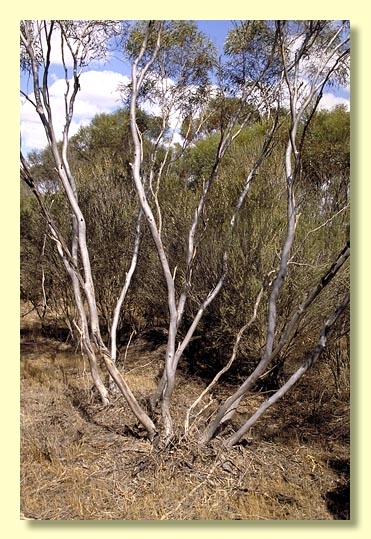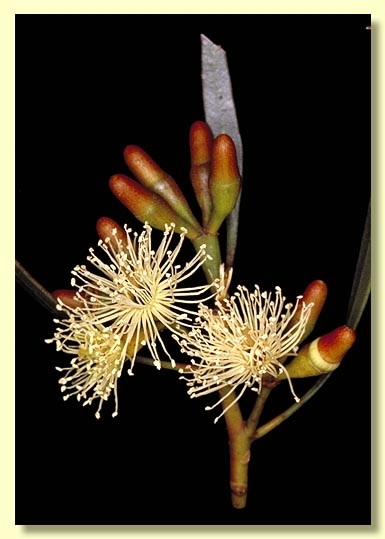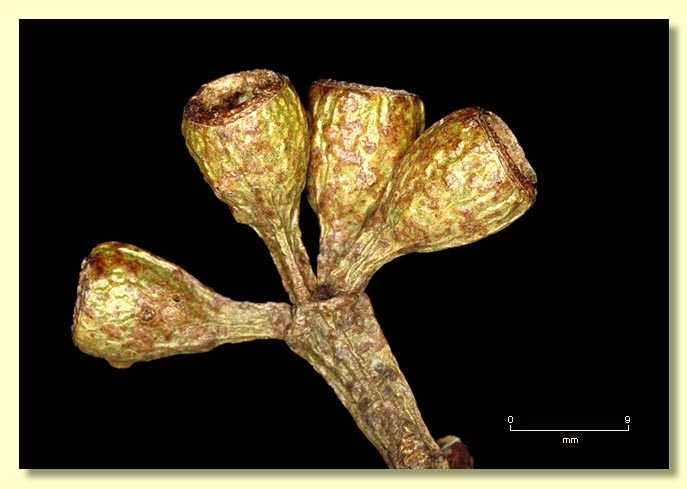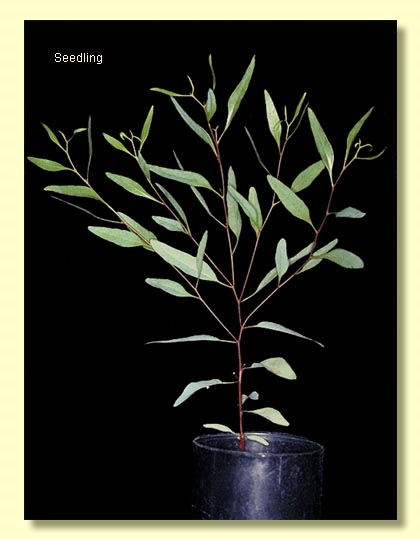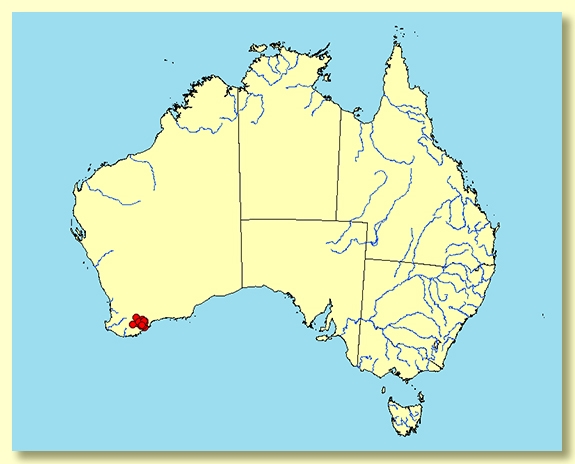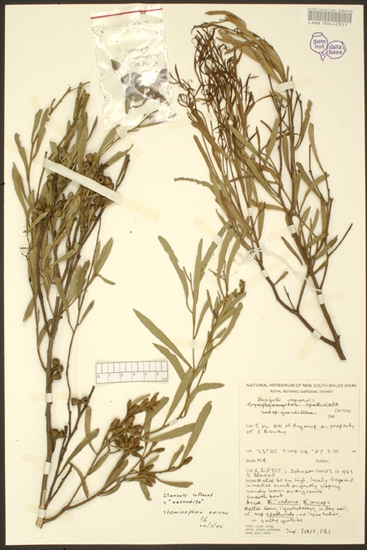Euclid - Online edition
Eucalyptus vegrandis subsp. vegrandis
Eucalyptus | Symphyomyrtus | Bisectae | Glandulosae | Clinatae
Bark smooth throughout, shedding in short ribbons, green-bronze to yellowish green over pinkish grey to brown.
Branchlets have oil glands in the pith.
Juvenile growth (coppice or field seedlings to 50 cm): not seen.
Adult leaves alternate, petioles 0.5–1.4 cm long; blade; blade linear to narrowly lanceolate or narrowly elliptical, (3)4.5–7.5 cm long, (0.3)0.4–1(1.3) cm wide, base tapering to petiole, margin distantly notched or entire, apex pointed or rounded, glossy, green, surface may appear "glazed" surface, side-veins and reticulation obscured by numerous round oil glands, intramarginal vein present or obscure.
Inflorescence axillary unbranched, peduncles erect to spreading, usually flattened, 0.5–1.6 cm long, buds 7, pedicellate (pedicels 0.1–0.5 cm long). Mature buds elongated with hypanthium usually just wider than the operculum at the join, 0.9–1.3 cm long, 0.4–0.5 cm wide, scar present (outer operculum lost very early), inner operculum sometimes slightly warty, horn-shaped to bluntly conical, hypanthium with weak ridges extending from pedicel, outer stamens erect or terminally deflexed, inner stamens inflexed, anthers oblong, versatile, dorsifixed, dehiscing by longitudinal slits, style long and straight, stigma blunt, locules 4(5), the placentae each with 4 vertical rows of ovules. Flowers white to creamy white.
Fruit pedicellate (pedicels 0.1–0.5 cm long), cupular to obconical, (0.5)0.7–0.8(0.9) cm long, (0.5)0.6–0.7(0.8) cm wide, disc descending, valves 4(5), at rim level or slightly exserted.
Seeds brown, 0.8–1.5 mm long, flattened-ovoid, dorsal surface clearly but shallowly reticulate, hilum ventral.
Cultivated seedlings (measured at node 10): cotyledons Y-shaped (bisected); stems rounded in cross-section, usually smooth; leaves shortly petiolate, opposite for 2 to 5 nodes then alternate, linear to lanceolate, 5–7 cm long, 0.4–1 cm wide, dull grey-green to green for ca 10 nodes then becoming glossy.
Flowering has been recorded in January, February and May.
E. vegrandis is widely used in salinity reclamation plantings.
Eucalyptus vegrandis is a mallee species endemic to Western Australia from low-lying sites, often around flats or depressions dominated by saltbush, from Jerramungup west to Katanning and south to Cranbrook and Boxwood Hill. The stems are smooth and the adult leaves glossy, green appearing glazed. Typically it has at least the inner stamen inflexed in bud and the leaf venation obscured by numerous oil glands. Leaf width varies across the range with the most southerly and westerly populations having the widest leaves.
Nicolle & Brooker (2005) described broad-leaved mallees in the south and south-west of the range of E. vegrandis as a distinct subspecies, viz. Eucalyptus vegrandis subsp. recondita. The subspecies can be distinguished as follows:
E. vegrandis subsp. vegrandis
Adult leaves linear to narrowly elliptical, (0.3)0.4–1(1.3) cm wide; with a length:width ratio in the range 6.4-14.2. Occurs from Ongerup to Katanning, Nyabing and Jerramungup. In the field subsp. vegrandis is most likely to be confused with, and co-occurs with, the more widespread E. orthostemon which has fully erect stamens in bud.
E. vegrandis subsp. recondita
Adult leaves broad, elliptical to oblanceolate, (0.8)1.3–2.5 cm wide, with a length:width ratio in the range 2.1-7.9. Occurs from Cranbrook eastwards around the fringes of the Stirling Range, but not on the Stirling Range itself. Most likely to be confused with broader-leaved forms of E. suggrandis subsp. suggrandis, and with E. thamnoides, both of which have fully erect stamens in the bud.
Eucalyptus vegrandis belongs in Eucalyptus subgenus Symphyomyrtus section Bisectae subsection Glandulosae because the buds have an operculum scar, cotyledons are bisected and branchlets have oil glands in the pith. Subsection Glandulosae is a very large group of ca 80 species. E. vegrandis occupies an uncertain position as it appears to be related to species in two different sub-groups in subsection Glandulosae: one group being the mallet E. spathulata and the mallee E. orthostemon, both with very narrow leaves, small similarly shaped buds cf. E. vegrandis but with erect stamens inside the bud, and occupying a similar saline habitat, plus E. suggrandis subsp. suggrandis, a mallee species from heathlands with erect stamens in slightly larger, warty buds; and the other group comprising the mallet E. cernua and mallee E. proxima, both of which have completely inflexed stamens in bud but differ from E. vegrandis in wider leaves and larger, 2-ribbed buds and fruit and colourful flowers.
Correct identification of E. vegrandis requires inspecting the arrangement of stamens inside the bud by sectioning it longitudinally and looking at it with a hand lens—the outer stamens will be more or less erect but the inner stamens will be inflexed. The plant habit, especially the presence or absence of a lignotuber, will also need to be known accurately.
Plants of Eucalyptus vegrandis in the area from Beaufort Inlet to the Bremer River may be intermediate between the subspecies.


